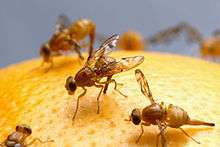Anastrepha ludens
| Anastrepha ludens | |
|---|---|
 | |
| Scientific classification | |
| Kingdom: | Animalia |
| Phylum: | Arthropoda |
| Class: | Insecta |
| Order: | Diptera |
| Family: | Tephritidae |
| Genus: | Anastrepha |
| Species: | A. ludens |
| Binomial name | |
| Anastrepha ludens Loew, 1873 | |
Anastrepha ludens, the Mexican fruit fly, is a species of tephritid or fruit flies in the genus Anastrepha.[1]
Anastrepha ludens, native to Mexico and Central America, is a major pest of agriculture across the Americas. They are highly reproductive and have a long lifespan when compared to other fruit flies.
Introduction Into the US
The Mexican fruit fly is an invasive species which was introduced into the US in 1903.[2] In 1903, the first few flies were spotted outside of their native habitat of Mexico and Central America, in small colonies in Texas. Which used to be part of Mexico. In 1927, some farmland was found infested with Mexican fruit fly larva. In 1954, the fly spread all around the country, infesting farmland in counties in California, Texas, Florida, and Arizona.
Agricultural Impact
The fruit fly is an agricultural pest that has caused 1.44 billion dollars in crop losses. They can infect a wide variety of plants. They prefer to feed on citrus fruits but will also feed on other plants if they are not available. They infect oranges, pomegranate, custard apple, and grapefruit.[3]
Ecology
Males can live for many months and occasionally can live for a full year. Females survive longer than males and can sometimes live for 16 months. The Mexican fruit fly goes through four phases of growth. They start their life out as an egg, then a larva, a pupa, and an adult fly. The rate at which they mature is directly related to the environment that they live in. A general rule is that the warmer the area in which they live, the faster the more rapidly they develop. Their life starts when a female lays eggs. They are usually laid in groups of ten eggs. These eggs are laid on the surface of fruits, especially those with broken skin or exposed flesh. The eggs hatch six to ten days later and they enter their second stage of development, the larval stage. The larvae burrow their way into the fruit and begin to devour the fruit from the inside. This stage lasts for three to four weeks, depending on the temperature and conditions. While inside the fruit, the larvae continue to grow until they are old enough to enter their next stage of development, the pupal stage. After the larvae are old enough, it begins to pupate. During this stage, the larvae grow wings and metamorphosize into a fly. This is analogous to the caterpillar retreating into a cocoon to become a butterfly. After it matures, the fly emerges as an adult. The adult fly then mate and lay more eggs, restarting the cycle. The female fly can lay over 1500 eggs in its lifetime.[4]
Management
The Mexican fruit fly has not been spotted in the US for many years because of many management tactics used by the USDA to control the threat of an invasion. The USDA has placed a quarantine on these flies so that if any are spotted, that area is to be isolated. Also, the USDA has released many sterile male flies into the environment. The sterile flies mate but do not produce offspring, causing the population to slowly die off. Also, there are commercially available pheromones that are used by farmers to detect infestations early. Because of these measures, the population has been under control.
References
Weems, H.V., Jr., Heppner, J.B., & Steck, G. J. (2001, March). Featured creature
by the University of Florida. Retrieved October 9, 2015, from
http://entnemdept.ufl.edu/creatures/fruit/tropical/mexican_fruit_fly.htm
US Department of Agriculture, APHIS Fact Sheet, Mexican Fruit Fly, Doc. (1993).
- ↑ Mexican fruit fly on ntnemdept.ufl.edu
- ↑ http://www.invasivespeciesinfo.gov/animals/mexfly.shtml
- ↑ Weems, H.V., Jr., Heppner, J.B., & Steck, G. J. (2001, March). Featured creature by the University of Florida. Retrieved October 9, 2015, from http://entnemdept.ufl.edu/creatures/fruit/tropical/mexican_fruit_fly.htm
- ↑ Weems, H.V., Jr., Heppner, J.B., & Steck, G. J. (2001, March). Featured creature by the University of Florida. Retrieved October 9, 2015, from http://entnemdept.ufl.edu/creatures/fruit/tropical/mexican_fruit_fly.htm
External links
- Species Profile- Mexican Fruit Fly (Anastrepha ludens), National Invasive Species Information Center, United States National Agricultural Library. Lists general information and resources for Mexican Fruit Fly.
| Wikimedia Commons has media related to Anastrepha ludens. |